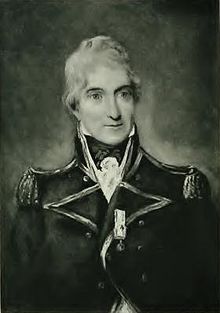Charles Tyler
GCB | |
|---|---|
 | |
| Born | 1760 Cavan[1] |
| Died | 28 September 1835 Gloucester |
| Buried | St Nicholas Church, St Nicholas, Cardiff, Wales |
| Allegiance | Great Britain and Ireland |
| Service | |
| Rank | Admiral |
| Commands | HMS Meleager Cape of Good Hope Station |
| Battles / wars | |
Admiral Sir Charles Tyler,
Early life
Tyler was born in
French Revolutionary Wars and Napoleonic Wars
Upon the outbreak of the
Transferring to
During the
Trafalgar
At Trafalgar, Tyler was originally second in line from
Struggling back to
Later career
Tyler's continued service brought more honours, including command of the
Family
He married two times. His first wife was Anne Rice with whom he had three children. She died early into the marriage leaving him as a young widower. He remarried and his second wife was Margaret Leach with whom he had three children. From this marriage one of his sons called George Tyler followed him into the navy and rose to the rank of Vice-Admiral. It later emerged that Admiral Nelson had cleared debt for the George Tyler while he was a junior officer with a strong reprimand shortly before the Battle of Trafalgar. George settled down and got married and through this marriage his daughter Caroline Tyler was born. She married the Earl of Dunraven and Mount Earl and the couple inherited Adare Manor in Ireland. Her son Colonel Windham Wyndham-Quin wrote the biography on his famous great-grandfather titled 'Sir Charles Tyler – Admiral of the White'. In 2005 the family sold Admiral Tyler's sword at Bonham's auction house for $430,000. The family tree of the Tylers shows the family was divided between living in Wales and Ireland with several rising to the highest ranks of the army and the navy with several Admirals and Generals listed through several generations including a great-grandson Admiral Godfrey Harry Brydges Mundy.
Further reading
- Sir Charles Tyler, G.C.B., admiral of the White, Colonel Wyndham-Quin, 1912, London
- The Trafalgar Captains, Colin White and the 1805 Club, Chatham Publishing, London, 2005, ISBN 1-86176-247-X
See also
- O'Byrne, William Richard (1849). . . John Murray – via Wikisource.
References
- ^ "The National Archives – Trafalgar Ancestors".
- ^ "The National Archives – Trafalgar Ancestors".
- ^ "Sir Charles Tyler, G.C.B., admiral of the White". 1912.
- ^ "Sir Charles Tyler, G.C.B., admiral of the White". 1912.
- ^ "The National Archives – Trafalgar Ancestors".
- ^ 5 April 1779
- ^ 31 December 1782
- ^ 21 September 1790
- ^ Hiscocks, Richard (17 January 2016). "Cape Commander-in-Chief 1795-1852". morethannelson.com. Retrieved 19 November 2016.
- Rear Admiralof the Blue 28 April 1808, of the Red 31 July 1810
- ^ KCB 20 April 1816
- ^ Vice Admiral of the Blue 4 December 1813, of the White 4 June 1814, of the Red 19 July 1821
- ^ Admiral of the Blue 27 May 1825, of the White 22 July 1830
- ^ GCB 1 May 1833
